Publications
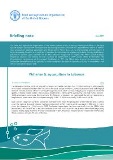
Fisheries & aquaculture in Lebanon - Briefing note
2022
The Lebanese coastline is 220 km long with a narrow continental shelf (less than 1 200 km2 with up to 200 m depth), which rarely extends beyond an 8 km strip from the coast, except for North Lebanon. Lebanon's large hydrological network includes a dozen of rivers running through the coast, which consequently plays an important role in the quality of marine coastal waters.
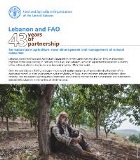
Lebanon and FAO 43 years of partnership for sustainable agriculture, rural development and management of natural resources
2022
This publication covers the work of FAO in Lebanon highlighting ongoing projects. It explains FAO’s assistance to Lebanon which has focused on the promotion of sustainable development of the agriculture sector, in close collaboration with the Ministry of Agriculture and other relevant ministries.
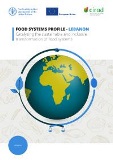
Catalysing the sustainable and inclusive transformation of food systems
2022
Food systems are intimately linked to our lives – through the food we eat, our nutrition and health, our livelihoods, jobs, and the environment and natural resources of the planet. The main challenge for food systems is to produce nutritious food for all while preserving our biodiversity and environment and ensuring equitable distribution of wealth.
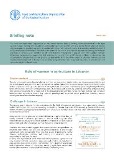
Role of women in agriculture in Lebanon - Briefing note
2022
The Food and Agriculture Organization of the United Nations (FAO) is leading international efforts in the fight against hunger. Serving both developed and developing countries, FAO acts as a neutral forum where all nations meet as equals to negotiate agreements and debate policy. FAO is also a source of knowledge and information. It helps developing countries and countries in transition to modernize and improve agriculture, forestry, and fisheries practices to achieve good nutrition for all.
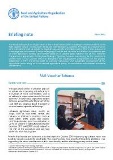
FAO Voucher Scheme – Briefing note
2022
The agricultural sector in Lebanon plays an important role in securing self-sufficiency in a number of food commodities, and is considered a major cornerstone in the rural economy.
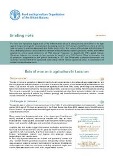
Role of women in agriculture in Lebanon - Briefing note mrt/21
2021
The Food and Agriculture Organization of the United Nations (FAO) is leading international efforts in the fight against hunger. Serving both developed and developing countries, FAO acts as a neutral forum where all nations meet as equals to negotiate agreements and debate policy.

Improved Water Resources Monitoring System/ Integrated Water Resources Management at regional level in Lebanon Managing assets of the irrigation system
2021
In many areas of the world, including the Near East and North Africa (NENA) region and Lebanon, sustainable and reliable delivery of water for irrigation and municipal use has become increasingly complex.

Improved Water Resources Monitoring System/Integrated Water Resources Management at regional level in Lebanon Water accounting tool
2021
In many areas of the world, including the Near East and North Africa (NENA) region and Lebanon, sustainable and reliable delivery of water for irrigation and municipal use has become increasingly complex.
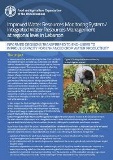
Improved Water Resources Monitoring System/Integrated Water Resources Management at regional level in Lebanon Informed decisions transferred to end-users to improve capacity for enhanced crop water productivity
2021
In many areas of the world, including the Near East and North Africa (NENA) region and Lebanon, sustainable and reliable delivery of water for irrigation and municipal use has become increasingly complex.
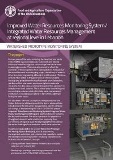
Improved Water Resources Monitoring System/Integrated Water Resources Management at regional level in Lebanon Watershed Prototype Monitoring System
2021
In many areas of the world, including the Near East and North Africa (NENA) region and Lebanon, sustainable and reliable delivery of water for irrigation and municipal use has become increasingly complex.
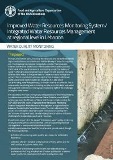
Improved Water Resources Monitoring System/ Integrated Water Resources Management at regional level in Lebanon Water Quality Monitoring
2021
In many areas of the world, including the Near East and North Africa (NENA) region and Lebanon, sustainable and reliable delivery of water for irrigation and municipal use has become increasingly complex.
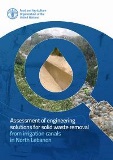
Assessment of engineering solutions for solid waste removal from irrigation canals in North Lebanon
2021
Waste management in Lebanon is a significant issue anticipating cascading and spill-over effect on livelihood, environment and agriculture. North Lebanon has been experiencing population growth spurts due to humanitarian crises in neighbouring countries that contributes to the urgency of finding sustainable solutions.

Improved Water Resources Monitoring System / Integrated Water Resources Management at regional level in Lebanon Real-time monitoring at key locations
2021
In many regions of the world, including the NENA region and Lebanon, sustainable and reliable delivery of water for irrigation and municipal use has become increasingly complex and problematic.

Enhance the capacity of the Ministry of Agriculture for evidence-based planning through pilot tracer studies
2021
Within FAO project “upgrading the technical agricultural education system in Lebanon”, in collaboration with ILO and the Ministry of Agriculture (MOA), the Consultation and Research Institute (CRI) conducted in December 2019 this tracer study targeting agriculture graduates from Baccalaureate Technique in the Agriculture (BTA) and Short-Term Courses (STC) for the cohorts from 2016-2017 and 2017-2018. Preparation
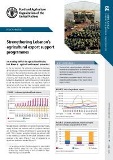
Strengthening Lebanon’s agricultural export support programmes
2021
The main factors limiting the growth of trade in Lebanese agricultural and food products include limited access to international markets, product quality and certification, inadequate trade infrastructure, lack of competitiveness, lack of trade agreements, and difficulties in substituting imported goods with domestic products.
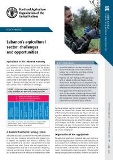
Lebanon’s agricultural sector: challenges and opportunities
2021
The Agricultural Sector Review (ASR) provides an up to date picture of the current socio-economic situation of the agricultural sector in Lebanon, along with identifying key challenges of the sector and evidence-based strategies for policymaking.
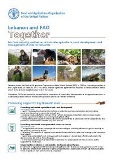
Together for food security, resilience, sustainable agriculture, rural development and management of natural resources
2021
Lebanon is a small country with several agro-ecological zones and agriculture arable land estimated at 231 000 ha. The most fertile and productive lands are located in the Bekaa Valley, the Plain of Akkar and the thin strip of coastal plains.
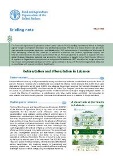
Reforestation and afforestation in Lebanon – Briefing note
2020
Lebanon’s forests cover up to 13 percent of the country’s surface area and other wooded lands account for about 11 percent. However, forested and wooded lands were subject to intense human pressure that led to their rapid degradation during the last 60 years.
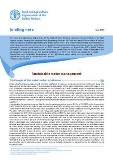
Sustainable water management - Briefing note
2020
One of FAO’s strategic objectives focuses on promoting the sustainable management of land, forest and water resources, particularly in the context of climate change.
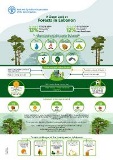
A closer look at the forests in Lebanon
2020
In Lebanon, forests and other wooded lands provide a wide range of ecosystem products and services. In 2014, the Ministry of Agriculture (MoA) initiated with the support of FAO Lebanon the process of developing the National Afforestation/Reforestation Program (NARP), also known as the “40 Million Trees Program”.
